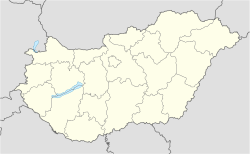Top Qs
Timeline
Chat
Perspective
Nyírbátor
Town in Szabolcs-Szatmár-Bereg, Hungary From Wikipedia, the free encyclopedia
Remove ads
Nyírbátor (Hungarian: [ˈɲiːrbaːtor]) is a town in Szabolcs–Szatmár–Bereg County, in the Northern Great Plain region of eastern Hungary. The town contains 15th and 16th century ecclesiastic and secular architectural heritage.
Remove ads
Geography
It covers an area of 66.73 km2 (26 sq mi) and has a population of 12,259 (2015).[1] The town forms the largest and most important population centre of the southern Nyírség region of Hungary.
History
The first written record of the settlement dates from 1279. Its name is derived from the Old Turkish word 'batir', or Mongolian 'bator' (originally meaning a 'good hero' and corresponding to 'bátor' in modern Hungarian). At that time, the ancestors of the Báthory's, the Gutkeled clan, already owned the land. The town became the administrative centre of their estates and also the family burial site. The family owned the town until the death of Gabriel Báthory,[2] Prince of Transylvania, in 1613.
In 1549, the legates of King Ferdinand I and Isabella ceded Transylvania to the Kingdom of Hungary. During the decades that followed there was a lasting dispute over ownership of the town, with the local aristocrats more inclined to recognize the sovereignty of the ruling prince of Transylvania.
By the 18th century, the town had become impoverished. In the course of the 1872 reorganization of public administration it lost its city status, which it regained in 1973.
Remove ads
Sights
The town is the site of several heritage buildings, the most well-known of which is what is now the Reformed Church. Built between 1488 and 1511, which is considered an example of International Gothic structures in Hungary. The late Renaissance-style belfry next to it is the largest wooden bell tower in the country.
Franciscan friars built their friary church around 1480 in a late Gothic style. Standing near the church is the building which now houses the István Báthori Museum. Originally a Baroque Minorite friary, it was built on the site of an earlier monastery.
Sport
The association football club, Nyírbátori FC, is based in Nyírbátor.
Photo gallery
- István Báthori Museum
- Our Lady church
- Reformed church
- Reformed belfry
- Town hall
Notable people
- Elizabeth Bathory (1560–1614), Hungarian countess and prolific female serial killer
- Meshulam Gross (1863–1947), Hungarian American entrepreneur
Twin towns – sister cities
 Carei, Romania
Carei, Romania Khust, Ukraine
Khust, Ukraine Rawa Mazowiecka, Poland
Rawa Mazowiecka, Poland Șimleu Silvaniei, Romania
Șimleu Silvaniei, Romania Vynohradiv, Ukraine
Vynohradiv, Ukraine
See also
References
External links
Wikiwand - on
Seamless Wikipedia browsing. On steroids.
Remove ads










